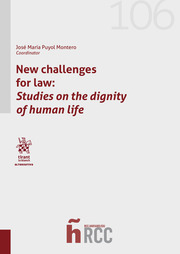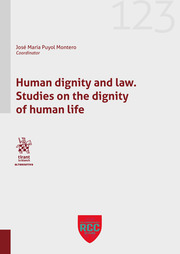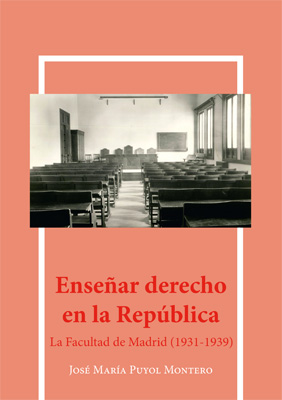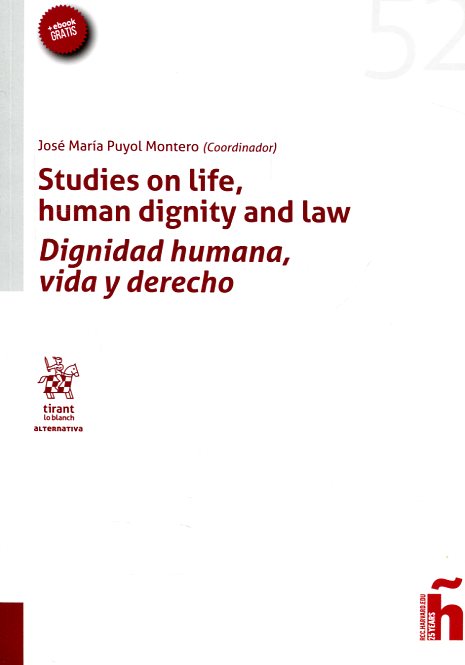New challenges for law
studies on the dignity of human life
- ISBN: 9788413138305
- Editorial: Editorial Tirant lo Blanch
- Fecha de la edición: 2020
- Lugar de la edición: Valencia. España
- Colección: Alternativa
- Encuadernación: Rústica
- Medidas: 24 cm
- Nº Pág.: 301
- Idiomas: Español

On the 3rd June 2016 and 22nd June 2018 two seminars organized by RCC Study Group "Studies on Life and Human Dignity" were held at Harvard Law School (Cambridge, Massachusetts). Both seminars gathered well-renowned professors from diff erent fi elds of science from European and American universities. The aim was to study and analyze the concept of human dignity in life and at the time of death, and some of its manifestations and potential threats in today?s world. In the last decades, a spectacular development in the diverse fi elds of science, economy, and trade and communications has taken place in society. These advances in human progress, as laudable as they may be, sometimes do not eff ectively correspond to parallel recognition of every man and woman?s human dignity. In fact, in many cases, this progress results in a series of contradictions and possible dangers and challenges. This book brings together a selection of papers presented at those seminars regarding the big issue of human dignity and law.
Prologue. Frontiers of dignity. An introduction 15
Introduction 23
Dignity: A philosophical approachexploration
Francesc Torralba
I. INTRODUCTION 27
II. POLYSEMY OF DIGNITY 28
III. BRIEF BEGRIFFSGESCHICHTE OF DIGNITY 33
IV. MAIN FORMS OF DIGNITY 35
Human Dignity and Two Ways of its Understanding
Aleksander Stpkowski
I. INTRODUCTION 43
II. RATIONALITY AS IT USED TO BE UNDERSTOOD 44
III. RATIONALITY MODERNISED 47
IV. TWO PARADIGMS CONFRONTED 51
V. CONSEQUENCES 53
VI. CONCLUSION 57
Legal personality and human dignity
Juan Antonio Martínez Muñoz
I. MEANINGS OF THE NOTION 61
1. The utilitarian meaning 62
2. The human dignity as political condition 63
3. Human dignity as a cultural meaning 65
4. The personal meaning of dignity 66
II. SOME LEGAL EXAMPLES 68
III. PERSONALITY AND TECHNOLOGY 71
At the 70th Anniversary of the Universal Declaration of Human Rights of United Nations: Fostering the protection of the fundamental freedoms based on human dignity
Liviu Olteanu
I. INTRODUCTION 75
II. CHALLENGES AND RISKS ON THE 70th ANNIVERSARY OF THE UN UNIVERSAL DECLARATION OF HUMAN RIGHTS 78
III. HUMAN DIGNITY IN THE XX AND XXI CENTURIES vs. LEGISLATION. CASE STUDY: ROMANIA 81
IV. FOSTERING FUNDAMENTAL FREEDOMS: WHY AND HOW 89
V. THE PATTERN OF THE “DIALOGUE FIVE” ACTORS AS A SUPPORT TO FIND AGREEMENT ON ALL CONCERNED CONTEMPORARY DEBATES 97
VI. CONCLUSION 101
Debating disability and human dignity: Foundations of a human right to “Universal Accessibility”
María Teresa García-Berrio H.
I. INTRODUCTION 105
II. NO ONE CAN FULLY ENJOY A RIGHT IF THEY CANNOT HAVE ACCESS TO… 106
III. WE ARE ALL PERSONS WITH DISABILITIES: THE INDIVIDUAL MODEL OF DISABILITY VS. THE SOCIAL MODEL OF DISABILITY 108
IV. NIHIL DE NOBIS, SINE NOBIS: THE HUMAN RIGHTS MODEL OF DISABILITY 111
V. UNIVERSAL ACCESIBILITY: PROMOTING A “GOOD LIFE” FOR THE “HIGHEST NUMBER” OF PEOPLE 114
Data privacy and human dignity a legal approach in an interconnected world
María-Luisa Gómez Jiménez
I. INTRODUCTION 121
Part I: THE CONCEPT
II. DIGNITY IN THE INTERNATIONAL LEGAL BODIES AND WITHIN THE GLOBAL ADMINISTRATIVE LAW 123
III. CASE BY CASE: KEY ELEMENTS TO DIFFERENTIATE DIGNITY FROM OTHER SIMILAR CONCEPTS: AN ESSAY 129
Part II: DATA PRIVACY AND HUMAN DIGNITY: THINKING AHEAD
IV. THE PROTECTION OF DATA PRIVACY: NAVIGATING IN TROUBLED WATERS 132
V. DATA PRIVACY: THE RULE OF LAW AND THE RESPECT TO INTIMACY IN THE INTERFACE CITY 133
VI. GOING SMART ABOUT DIGNITY: NUDGING TOWARDS THE CONCEPT OF HUMAN DIGNITY? 136
VII. FINAL REMARKS: THE DE-CONSTRUCTION OF HUMAN DIGNITY IN AN INTERCONNECTED WORLD 137
Conscientious objection and anti-bioethics: An analysis from the perspective of the Spanish constitutional court
José-Miguel Serrano Ruiz-Calderón
I. CONSCIENTIOUS OBJECTION AND ANTI-BIOETHICS: AN ANALYSIS FROM THE PERSPECTIVE OF THE SPANISH CONSTITUTIONAL COURT 141
Forever young? Ethics and policies on increasing human lifespan
Vicente Bellver Capella
I. CONTEXT: THE SEARCH FOR IMMORTALITY BETWEEN HEALTHY AGING AND THE POST-HUMANIST MOVEMENT 154
II. REASONS: WHY WE SHOULD REJECT THE IMMORTAL LIFE PROJECT 161
III. POLICIES: WHAT TO DO IN THE FACE OF EXTRA LONGEVITY PROJECTS FOR HUMAN LIFE 166
IV. CONCLUSION 171
Back on four years of societal debates in France, about end-of-life issues concluded by the law of february the second, two thousand sixteen (2016)
Didier Sicard MD
I. Back on four years of societal debates in France 173
Euthanasia, Law, Religion, Culture: Observations from a Pioneering Country
Theo A. Boer
I. INTRODUCTION 179
II. THE 2001 EUTHANASIA ACT AND ITS HISTORY 179
III. RELIGION AND EUTHANASIA 182
IV. DEVELOPMENTS SINCE 2001 189
V. REFLECTIONS ON LAW AND PRACTICE 194
A critical review of the case-law of the European Court of Human Rights on the right to die with dignity
Santiago Cañamares Arribas
I. INTRODUCTION 201
II. DETERMINING THE LEGAL FRAMEWORK OF THE “RIGHT TO DIE WITH DIGNITY” IN THE EUROPEAN CONVENTION OF HUMAN RIGHTS 204
III. PRIVATE LIFE, EUTHANASIA AND PHYSICIAN ASSISTED SUICIDE 206
IV. RIGHT TO LIFE, DIGNITY AND THERAPEUTIC OBSTINACY 209
1. Patients in a persistent vegetative state 210
2. Minors and therapeutic obstinacy 213
V. CONCLUSIONS 216
Completed lives and the accumulation of age-related complaints. A new trend in Dutch euthanasia practice?
Martin Buijsen
I. INTRODUCTION 219
II. EUTHANASIA IN THE NETHERLANDS 221
1. Schoonheim (1985) 222
2. Chabot (1994) 223
3. Euthanasia Act (2002) 224
4. Brongersma (2002) 225
III. DEVELOPMENTS OUTSIDE DUTCH EUTHANASIA PRACTICE 226
1. Completed Life citizens’ initiative (2010) 227
2. Schnabel Committee (2016) 228
3. Heringa (2018) 230
4. Coöperatie Laatste Wil (2018) 234
IV. DEVELOPMENTS IN DUTCH EUTHANASIA PRACTICE 235
1. “Suffering from life” (2010) 236
2. Accumulation of age-related complaints and dimensions of suffering (2011) 238
3. Code of Practice (2015) 240
4. Numbers 242
V. COMMUNICATING VESSELS 243
Death penalty in adversarial and inquisitorial legal tradition: The crime of witchcraft
María-Jesús Torquemada Sánchez
I. FOREWORD: THE STARTING POINT 245
II. THE DICHOTOMY: ADVERSARIAL AND INQUISITORIAL SYSTEMS. THE REASONS FOR PREFERRING THE ADVERSARIAL SYSTEM AND THE RESULTS 246
III. THE REASONS FOR PREFERRING THE ADVERSARIAL SYSTEM 259
IV. THE RESULTS 260
V. THE EXECUTION OF DEATH PENALTY IN WESTERN TRADITION: DIGNITY AND PUBLIC SHAME TAKING THE EXAMPLE OF THE CRIME OF WITCHCRAFT 263
VI. CONCLUSIONS 266
Towards a new model of capital punishment in western countries in the nineteenth century
José-María Puyol Montero
I. INTRODUCTION 269
II. WHEN THE DEATH PENALTIES WERE EXECUTED IN PUBLIC 271
III. A MODEL OF THE DEATH PENALTY IN CRISIS? 277
IV. A NEW MODEL OF CAPITAL PUNISHMENT IN THE NINETEENTH CENTURY: HUMANIZATION, VISIBILITY RESTRICTIONS AND NEW FORMS OF PUBLICITY 283
V. EXECUTIONS WITHIN PRISON WALLS: “PRIVATE EXECUTIONS” 288
Abstracts/Resúmenes 293
Annex/Anexo 305









